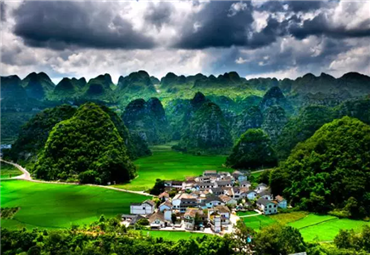500 million-year-old red stone forest to glow with vibrant life

The stone forest with different shapes and beautiful red and white colors has become one of the most impressive examples of Guizhou karst topography. [Photo by Long Yuanbin/For chinadaily.com.cn]
A massive red stone forest, called Shilin in Chinese, where stones resemble fossilized trees, has a history of nearly 500 million years. It covers an area of about 133 hectares on the top of Laer Mountain in Songtao Miao autonomous county of Tongren city, Guizhou province.
Hundreds of millions of years ago, there was a vast expanse of sea in Guizhou. The seabed deposited a large amount of sediments mixed with carbonate materials. As a result of crustal movement and sea receding, as well as the constant seeping of rain, the unique geological wonders were therefore produced.
Such a group of great stone sculptures of different shapes and beautiful red and white colors has become one of the most impressive examples of Guizhou karst topography.
Composed of carbonate rocks, mudstones and sandstones, those red stones have unique bedding texture and are rich in minerals of silicon and calcium elements, experts say. Due to its rare "pagoda type" stone forest in the world, Songtao red stone forest commands both high scientific research and appreciation value.
The government this year aims to develop the stone forest into a 5A scenic spot, featuring geological landform sightseeing, mountain sports and characteristic leisure tourism, with an estimated investment of 1.7 billion yuan($264.23 million), according to local authorities.
Wang Jin contributed to this story.
京ICP备13028878号-8







 Overview
Overview
 Guiyang
Guiyang
 Guian New Area
Guian New Area
 Liupanshui
Liupanshui
 Anshun
Anshun
 Qianxinan
Qianxinan
 Qiandongnan
Qiandongnan
 Qiannan
Qiannan
 Zunyi
Zunyi
 Tongren
Tongren
 Bijie
Bijie
 75 years on: Guizhou's great leap to prosperity
75 years on: Guizhou's great leap to prosperity
 China (Guizhou) Intl Alcoholic Beverages Expo
China (Guizhou) Intl Alcoholic Beverages Expo
 China Life Tips: Unlocking mobile payments
China Life Tips: Unlocking mobile payments


